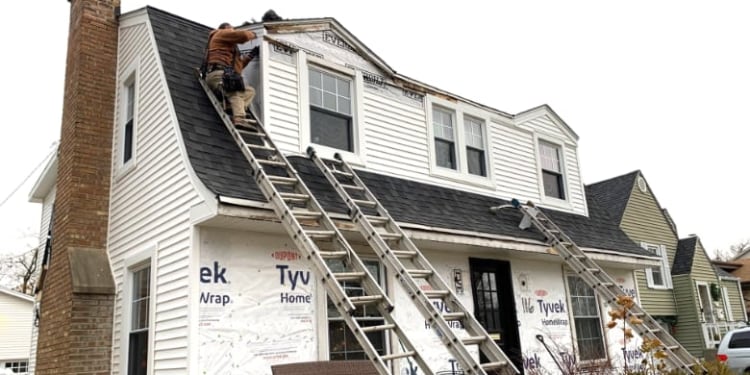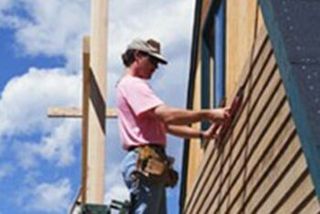Professional Morris Siding Contractor Offering Quick and Efficient Service
Professional Morris Siding Contractor Offering Quick and Efficient Service
Blog Article
The Crucial Guide to the Different Kinds of House Siding and Their Special Benefits
In the realm of home improvement, selecting the appropriate exterior siding is a critical choice that influences both visual appeal and practical performance. With so numerous options to take into consideration, which house siding product absolutely stands out for your details task?
Timber Home Siding
Wood siding, a popular choice for residential outsides, uses an ageless aesthetic that integrates natural appeal with structural stability. This exterior siding product is readily available in various designs, consisting of clapboard, roof shingles, and board-and-batten, allowing homeowners to customize their façade to match their style preferences. Timber home siding is typically crafted from sturdy varieties such as cedar, redwood, or want, which are known for their strength and capability to withstand ecological stressors.
One of the key benefits of timber home siding is its outstanding insulation residential properties, which can add to power efficiency and reduced home heating expenses. In addition, wood exterior siding is biodegradable, making it an ecologically pleasant choice when sourced sustainably. Normal maintenance, consisting of painting or discoloration, can prolong its life expectancy and enhance its appearance, allowing house owners to protect the natural beauty of the wood.
Nevertheless, potential disadvantages consist of vulnerability to insects, rot, and weather condition damages, necessitating appropriate therapy and maintenance - morris siding contractor. Despite these issues, when effectively cared for, wood house siding can offer a long lasting and attractive solution that enhances the character of a home while using a warm, inviting ambience

Plastic House Siding
Plastic home siding has actually become a leading choice for home owners looking for a low-maintenance exterior option that incorporates toughness and cost. This versatile product is crafted from polyvinyl chloride (PVC), making it resistant to numerous weather, consisting of wetness and UV rays. As a result, plastic home siding does not warp, rot, or discolor, guaranteeing long-lasting visual charm.
One of the key advantages of plastic house siding is its comprehensive series of shades and styles, enabling house owners to achieve the preferred search for their residential property without the need for constant repainting. Additionally, vinyl house siding is simple to install, which can significantly minimize labor prices during construction or restoration tasks.
Vinyl home siding additionally contributes to energy performance. Numerous choices function insulation support, which boosts thermal efficiency, helping to maintain comfy interior temperature levels and possibly lowering energy bills. Its smooth surface area facilitates easy cleaning, calling for just periodic washing with a garden hose to remove dust and particles.
Fiber Concrete Siding
Fiber concrete house siding has actually acquired traction amongst contractors and property owners alike due to its amazing combination of longevity and visual adaptability. Made up of a blend of sand, cellulose, and cement fibers, this home siding choice is engineered to withstand severe weather condition problems, including high winds, heavy rain, and temperature level variations, making it a resilient choice for household outsides.
Among the main benefits of fiber concrete siding is its resistance to parasites, such as termites, and its non-combustible nature, offering improved fire safety and security. morris siding contractor. Furthermore, it is readily available in a broad selection of styles, shades, and appearances, permitting property owners to achieve their preferred aesthetic without giving up efficiency
Another advantage is its low upkeep needs; fiber cement house siding normally calls for painting or discoloration every 5-10 years, which is much less constant than other materials. In addition, its durability adds to a reduced total cost of ownership, as it minimizes the demand for constant repair work or replacements.
Eventually, fiber cement home siding stands for an excellent investment for those seeking a resilient, attractive, and versatile exterior choice, integrating both type and feature to improve the home's visual charm.
Metal Exterior Siding
The appeal of steel home siding depends on its durable toughness and contemporary aesthetic allure, making it a favored selection for modern style. Readily available in products such as aluminum and steel, metal siding supplies a variety of coatings and visite site shades, allowing homeowners to achieve a customized look that matches their design vision.

Power effectiveness is an additional substantial benefit, as several steel exterior siding products are created with insulation choices that assist control interior temperatures. This can cause minimized energy expenses in time. Furthermore, metal exterior siding is typically recyclable, making it an eco-friendly choice for sustainability-minded property owners.
The setup process for metal house siding can be reasonably uncomplicated, leading to a quicker turnaround time for building projects. Generally, steel home siding integrates functionality and style, making it a sensible alternative for those looking for a long-lasting and aesthetically attractive exterior finish.
Block and Rock Home Siding
Brick and rock home siding sticks out as a timeless selection that improves the visual appeal of any type of home. Known for their durability and reduced maintenance, these products supply an outstanding roi while boosting the residential or commercial property's aesthetic charm. Available in different colors, textures, and patterns, brick and stone can be tailored to fit diverse building designs, from traditional to contemporary.
One of the main benefits of brick and rock exterior siding is their power efficiency. Both materials have all-natural insulating residential properties that help manage interior temperature levels, possibly minimizing cooling and heating expenses. In addition, they supply premium fire resistance compared to various other siding choices, adding to boosted security.
An additional benefit is their longevity. Brick and stone can last for decades, usually calling for minimal upkeep past periodic cleansing. Unlike timber house siding, they are unsusceptible pests and rot, guaranteeing a resilient exterior that holds up against the components.
Conclusion
In summary, the selection of exterior siding considerably affects a home's aesthetic appeal, energy effectiveness, and maintenance demands. Each kind of exterior siding-- whether wood, vinyl, fiber concrete, block, or metal and rock-- supplies one-of-a-kind advantages customized to numerous property owner choices and ecological conditions. Understanding these options makes it possible for informed choices that improve both the toughness and aesthetic charm of residential outsides. Inevitably, selecting the best siding is important for accomplishing a balance in why not try these out between performance and design in household style.
One of the main benefits of wood siding is its exceptional insulation residential or commercial properties, which can add to energy effectiveness and reduced home heating expenses. In addition, wood visit this website house siding is biodegradable, making it an ecologically pleasant choice when sourced sustainably.One of the key benefits of steel exterior siding is its resistance to numerous environmental aspects.Energy efficiency is an additional significant advantage, as lots of metal exterior siding items are designed with insulation options that assist manage indoor temperatures. Each kind of house siding-- whether timber, plastic, fiber brick, concrete, or steel and stone-- uses one-of-a-kind benefits tailored to various property owner preferences and environmental problems.
Report this page